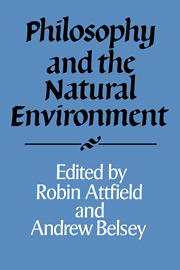Book contents
- Frontmatter
- Contents
- Preface
- Notes on Contributors
- Introduction
- Value in Nature and the Nature of Value
- Ecology and the Ethics of Environmental Restoration
- Rehabilitating Nature and Making Nature Habitable
- Personalistic Organicism: Paradox or Paradigm?
- Values, Reasons and the Environment
- Awe and Humility: Intrinsic Value in Nature. Beyond an Earthbound Environmental Ethics
- The End of Anthropocentrism?
- Global Religion
- Kant and the Moral Considerability of Non-Rational Beings
- The Idea of the Environment
- Chaos and Order, Environment and Anarchy
- Natural Capital
- Some Philosophical Assessments of Environmental Disobedience
- Global Environmental Justice
- Environmental and Medical Bioethics in Late Modernity: Anthony Giddens, Genetic Engineering and the Post-Modern State
- Highlights and Connections
- Bibliography
- Index
Environmental and Medical Bioethics in Late Modernity: Anthony Giddens, Genetic Engineering and the Post-Modern State
Published online by Cambridge University Press: 19 October 2009
- Frontmatter
- Contents
- Preface
- Notes on Contributors
- Introduction
- Value in Nature and the Nature of Value
- Ecology and the Ethics of Environmental Restoration
- Rehabilitating Nature and Making Nature Habitable
- Personalistic Organicism: Paradox or Paradigm?
- Values, Reasons and the Environment
- Awe and Humility: Intrinsic Value in Nature. Beyond an Earthbound Environmental Ethics
- The End of Anthropocentrism?
- Global Religion
- Kant and the Moral Considerability of Non-Rational Beings
- The Idea of the Environment
- Chaos and Order, Environment and Anarchy
- Natural Capital
- Some Philosophical Assessments of Environmental Disobedience
- Global Environmental Justice
- Environmental and Medical Bioethics in Late Modernity: Anthony Giddens, Genetic Engineering and the Post-Modern State
- Highlights and Connections
- Bibliography
- Index
Summary
Introduction: Modernity or Post-Modernity?
A controversial question among contemporary scholars is whether advanced industrial societies are still in modernity, or whether they are on the threshold of, or even have entered, a new post-modern order (see, for example, Bell, 1973; Lyotard, 1986, p. 14; Lash and Urry, 1987). In The Consequences of Modernity Anthony Giddens writes: ‘Beyond modernity, we can perceive a new and different order, which is “post-modern”, but this is quite distinct from what is at the moment called by many “post-modernity”’ (Giddens, 1990, p. 3). However, he does recognize that there is something perceptibly different about the present, which he characterizes as ‘late modernity’ (or ‘high modernity’), an era in which the consequences of modernity are more radicalized and globalized than before (Giddens, 1990, pp. 3, 51).
For Giddens, the essence of modernity is its dynamism—a dynamism of such pace and scope as to be discontinuous with traditional social orders. One of the images Giddens uses to describe the dynamic experience of living in modernity is that of riding a juggernaut—‘a runaway engine of enormous power which, collectively as human beings, we can drive to some extent but which also threatens to rush out of our control and which could rend itself asunder’ (Giddens, 1990, p. 139).
- Type
- Chapter
- Information
- Philosophy and the Natural Environment , pp. 211 - 226Publisher: Cambridge University PressPrint publication year: 1994



